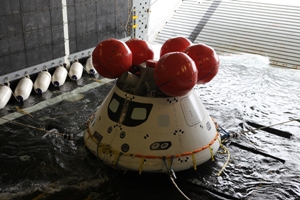In a simulated ocean recovery of an Orion spacecraft test article, Lockheed Martin, NASA and the U.S. Navy practiced recovery techniques for retrieving the crew module after it splashes down at sea following its first test flight later this year. This test allowed the team to evaluate procedures, hardware and personnel responsible for the recovery.
 Orion Spacecraft Ocean Recovery. Photo: NASA
Orion Spacecraft Ocean Recovery. Photo: NASA
During the test, which took place off the coast of San Clemente Island, U.S. Navy dive teams retrieved and positioned the Orion test article on the USS Anchorage using a Lockheed Martin built recovery cradle, recovery winch, and sea anchor. The information gathered during this phase of testing will help ensure a safe and efficient recovery of the crew module and collection of flight test data after splashdown.
“Completing recovery simulations in a real, ocean environment before EFT-1 is incredibly helpful,” said Larry Price, Lockheed Martin Deputy Program Manager for the Orion program. “This test allows us to improve the procedures for handling the crew module and determine if the recovery equipment designs are precise, safe and efficient.”
Orion will complete its first test flight, Exploration Flight Test-1 (EFT-1), on December 4, 2014. During EFT-1, the uncrewed spacecraft will launch on a Delta IV Heavy rocket and will travel 3,600 miles beyond low Earth orbit—15 times further than the International Space Station. That same day, Orion will return to Earth at a speed of approximately 20,000 mph for a splashdown in the Pacific Ocean. The flight will provide engineers with data about systems critical to crew safety such as heat shield performance, separation events, avionics and software performance, attitude control and guidance, parachute deployment, and recovery operations to validate designs of the spacecraft before it begins carrying humans to new destinations in deep space.
Headquartered in Bethesda, Maryland, Lockheed Martin is a global security and aerospace company that employs approximately 113,000 people worldwide and is principally engaged in the research, design, development, manufacture, integration and sustainment of advanced technology systems, products and services. The Corporation’s net sales for 2013 were $45.4 billion.